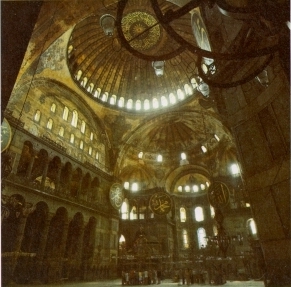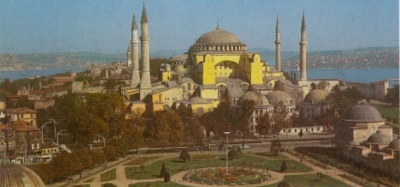
One of the most significant buildings of religious architecture, completed 27 December 537 AD.
The site known as "Holy Wisdom" (Hagia Sophia) in Constantinopolis, the capital of the Eastern Roman Empire, was the location of a Christian church from very early on. When the church was burnt to the ground during an uprising in 532, emperor Justinian decided to built a new church that surpassed everything seen before.
The new church was the design of the Greek scientists and architects Isidorus of Miletus and Anthemios of Tralles. It was consecrated on 27 December 537. It is among the most notable achievements of human architecture. Its central dome spans a diameter of 33 m. Such space could not be covered by a flat roof structure. Architects of earlier civilizations chose to cover such spaces with a hemispherical dome, which directs the weight down into the walls.
The dome of the Hagia Sophia is spherical but substantially less than a hemisphere, giving the interior the impression of greater width. This effect is further emphasized by 40 windows at the dome base, which make the structure appear nearly weightless and fill the interior with dazzling light.

An earthquake on 6 December 557 damaged the dome, and it collapsed 6 months later on 7 May 558. Reconstruction began immediately, and the church was consecrated a second time on 26 December 562. The second dome, which still stands today, has a slightly smaller radius and is thus slightly more convex, reaching a total height of 65 m.
Because the dome is not hemispherical it directs the forces of its weight down at an outward angle. As a result, the outward appearance of the Hagia Sophia is dominated by massive rampart-like wall structures to support the dome.
In 1453 Arabian architects converted the Hagia Sophia into a mosque. The addition of four minarets provided a counterbalance to the support structures and improved the outer appearance of the building greatly.
The Hagia Sophia served as a point of reference for the great Ottoman architect Sinan of the 16th century.
